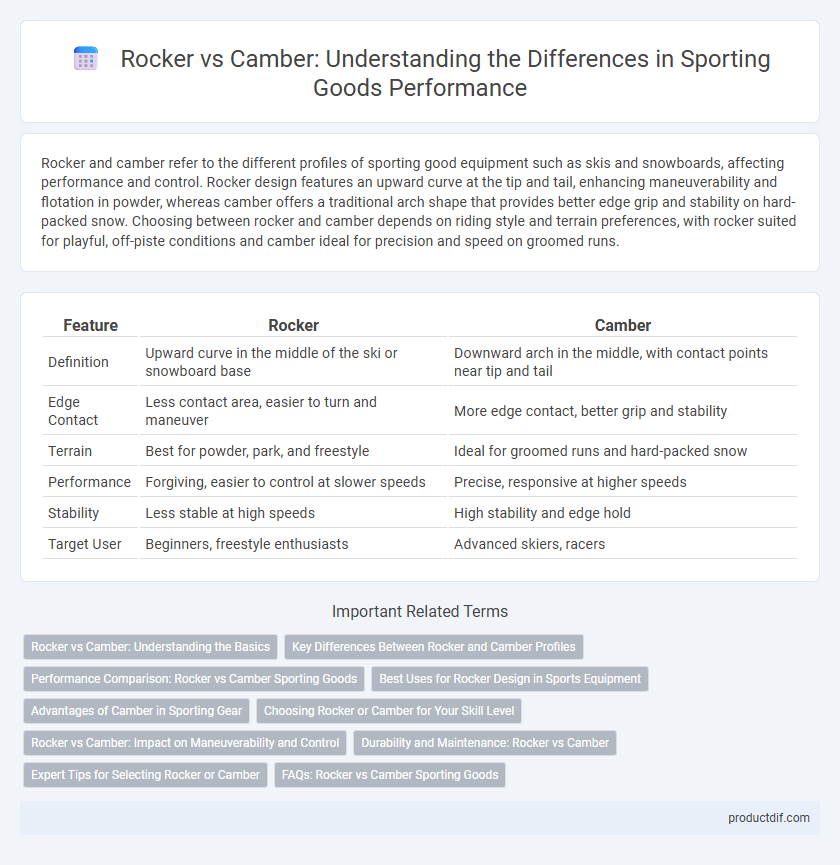Rocker and camber refer to the different profiles of sporting good equipment such as skis and snowboards, affecting performance and control. Rocker design features an upward curve at the tip and tail, enhancing maneuverability and flotation in powder, whereas camber offers a traditional arch shape that provides better edge grip and stability on hard-packed snow. Choosing between rocker and camber depends on riding style and terrain preferences, with rocker suited for playful, off-piste conditions and camber ideal for precision and speed on groomed runs.
Table of Comparison
| Feature | Rocker | Camber |
|---|---|---|
| Definition | Upward curve in the middle of the ski or snowboard base | Downward arch in the middle, with contact points near tip and tail |
| Edge Contact | Less contact area, easier to turn and maneuver | More edge contact, better grip and stability |
| Terrain | Best for powder, park, and freestyle | Ideal for groomed runs and hard-packed snow |
| Performance | Forgiving, easier to control at slower speeds | Precise, responsive at higher speeds |
| Stability | Less stable at high speeds | High stability and edge hold |
| Target User | Beginners, freestyle enthusiasts | Advanced skiers, racers |
Rocker vs Camber: Understanding the Basics
Rocker and camber are key snowboard and ski profile types affecting performance and control. Rocker features an upward curve for enhanced maneuverability and float on powder, while camber offers a traditional arch promoting edge hold and stability on hardpack snow. Choosing between rocker vs camber depends on terrain preference, riding style, and desired responsiveness.
Key Differences Between Rocker and Camber Profiles
Rocker profiles feature a convex shape with upward curves at the tip and tail, enhancing maneuverability and float on powder, while camber profiles maintain a concave shape with contact points near the tip and tail, offering superior edge control and stability on hardpack. Rocker skis excel in softer snow conditions and quick turns, whereas camber skis provide precise grip and rebound response on groomed trails. Many modern models combine both profiles, creating hybrid shapes that balance flotation and control for versatile performance across various terrains.
Performance Comparison: Rocker vs Camber Sporting Goods
Rocker and camber skis each deliver distinct performance benefits tailored to different conditions and skiing styles. Rocker skis excel in powder and soft snow by enhancing floatation and maneuverability, while camber skis provide superior edge hold, stability, and precision on groomed or hard-packed surfaces. Selecting between rocker and camber depends on terrain preference and skill level, with rocker favoring freeride and backcountry adventures, and camber optimizing control for carving and groomer runs.
Best Uses for Rocker Design in Sports Equipment
Rocker design in sports equipment, particularly in skis and snowboards, is best suited for powder and off-piste conditions due to its lifted tips and tails that enhance floatation and maneuverability. This design also benefits beginners by providing easier turn initiation and reducing edge catch, promoting smoother control on varied terrain. Rocker shapes excel in freestyle sports equipment, allowing athletes to perform tricks with greater balance and versatility.
Advantages of Camber in Sporting Gear
Camber in sporting gear provides superior edge control and stability, making it ideal for precise turns and aggressive maneuvers. Its upward curve design enhances power transfer by keeping the contact points consistently engaged with the surface, improving grip on snow or pavement. This makes camber equipment highly favored for advanced athletes seeking performance and responsiveness in skiing, snowboarding, and skateboarding.
Choosing Rocker or Camber for Your Skill Level
Choosing rocker or camber skis depends largely on your skill level and terrain preference. Rocker skis offer enhanced maneuverability and are ideal for beginners or those skiing in powder, while camber skis provide better edge control and stability favored by advanced skiers on groomed slopes. Assess your proficiency and typical snow conditions to select the optimal ski profile that maximizes performance and safety.
Rocker vs Camber: Impact on Maneuverability and Control
Rocker skis feature an upward curve at the tip and tail, enhancing maneuverability by enabling easier turn initiation and smoother transitions on varied terrain. Camber skis maintain continuous contact with the snow along their length, providing superior edge control and stability, especially on hard-packed surfaces. The choice between rocker and camber significantly affects skiing performance, with rocker favoring agility and camber emphasizing precise control.
Durability and Maintenance: Rocker vs Camber
Rocker skis typically offer enhanced durability due to their flexible design, which evenly distributes stress and reduces edge wear over time, making them ideal for varied terrain and softer snow conditions. Camber skis, with their traditional arch shape, provide consistent edge contact and superior stability on hard-packed snow, but they often require more frequent edge sharpening and maintenance to maintain optimal performance. Choosing between rocker and camber depends on balancing the need for lower maintenance with durability against the specific skiing conditions and terrain preferences.
Expert Tips for Selecting Rocker or Camber
Experts recommend choosing rocker skis for enhanced maneuverability and floatation in powder, ideal for freestyle and off-piste skiing. Camber skis provide superior edge grip and stability on groomed slopes, making them optimal for carving and high-speed turns. Evaluate your skiing style and typical terrain to select the appropriate rocker or camber design for peak performance and control.
FAQs: Rocker vs Camber Sporting Goods
Rocker and camber refer to the profiles of skis, snowboards, and other sporting equipment, impacting control and performance on varying terrains. Rocker profiles feature an upward curve in the tip and tail, enhancing maneuverability and float in powder, while camber profiles have a slight arch providing better edge hold and stability on hardpack or groomed trails. Choosing between rocker vs camber depends on the sport, snow conditions, and user skill level for optimal performance and safety.
Rocker vs Camber Infographic

 productdif.com
productdif.com